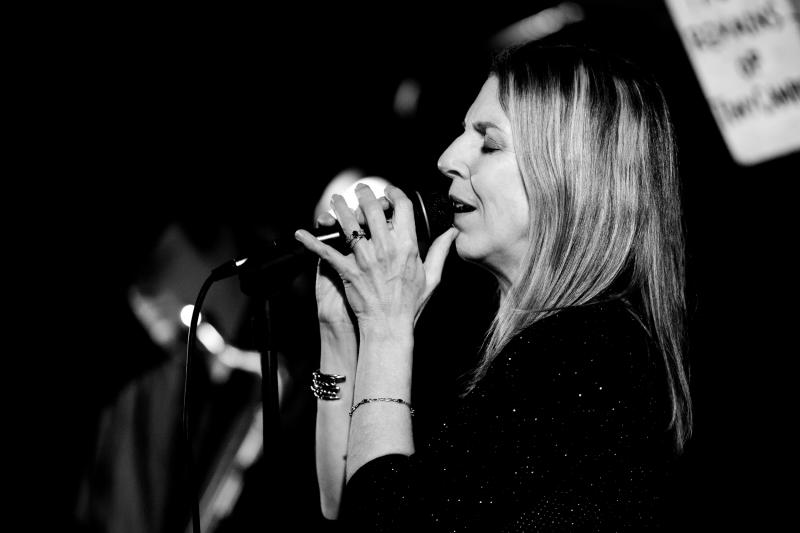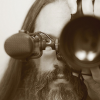Home » Jazz Articles » Behind the Lens With... » Behind the Lens With Victor Engel
Behind the Lens With Victor Engel

I was born in Canada and grew up in Guatemala, a child of missionary parent. In 1980 I moved to Texas where I got a degree in math. For most of my career I've been a database programmer, but one of my true loves is photography. In 1992 I moved to Austin for a job and fell in love with the city.
Because I've had a stable career as a database programmer, I've been free to explore my photography. At first, I had a dislike for people photography. But I've grown to appreciate it. I prefer to try to capture things as I see them—not creating a studio scene with artificially perfect lighting, composition, and posing. Recent advances in digital photography thankfully have made shooting in available light more possible than it's ever been.
Gear:
Currently, I shoot with Canon gear for the most part. Although the new Canon 5D Mark III looks interesting, I'll be sticking with my 5D Mark II for now. My go-to lens for jazz photography is my Canon EF 135mm f/2 lens. It's a little long for some people, but it suits my style. I generally dislike getting up in people's faces, or blocking the view of audiences. I'd rather be invisible to the artist as well as the audience. So I also don't use flash.
I have plenty of other gear for other styles of photography, but the 5D II/135L combo gets my 99% of my shots in music venues.
Teachers and/or influences?
My father was a photographer. He taught me about exposure, tripods, lenses, and I also assisted him in the darkroom. He got me my first camera, one that used Agfa Rapid film. After I used that a few years, he also got me my first 35mm camera, an Exakta Twin TL. When he became director of a museum in Dallas, he let me use the darkroom there.
I never took any formal courses, but did a lot of reading in magazines, such as Shutterbug, Popular Photography, and so forth. Photography was also discussed around the dinner table at home.
I guess I'd have to say my older brother was also an influence. He was given the same treatment I was from my father and also had a like interest in photography. He, though, pursued other fine arts and is now a professional architect.
When the photography world went digital, a whole new world was opened up. For those of us who got involved early on, we learned by challenging each other and participating in online forums. Those forums, finally, were a large influence in my development and understanding of digital photography, and the photo challenges, helped me to explore and learn different perspectives in composition, style, processing, and so forth.
I knew I wanted to be a photographer when...
Actually, I can't remember a time when I didn't want to be a photographer. I guess my desire was spurred by receiving my very first camera. I can still remember waiting in anticipation for the pictures to be developed to see how they turned out. It's amazing how a week-long wait has turned into a fraction of a second wait.
Your approach to photography:
I try to capture what I see. I think I see things a bit differently from how other people see things, and I think I capture some of that. It sometimes is a real challenge, though.
Occasionally, I will also design a picture first in my mind and then collect subject matter and pose things to craft the picture.
I rarely use flash. It's useful in macro photography but I dislike its use in people photography. I find it to be disruptive.

Your teaching approach/philosophy:
I think first, it's important for a photography student to grasp certain fundamentals. They should know about focal length, aperture, exposure, ISO, zoom, prime, stopping down, foreshortening, motion blur, etc. These are all concepts that relate to basic elements of photography. Just as a mathematician had to memorize the multiplication tables in a low grade, so a budding photographer should learn about these fundamentals.
Once these fundamentals are learned, the photographer is free to explore creatively. There should be no boundary to creativity.
Your biggest challenge when shooting indoor (or low lighted) events:
It used to be the case that low light levels were the biggest issue, and that still is a big issue. However, I think another major issue has been contending with the choices that someone else might have made with the lighting. Why on earth, for example, would a stage be illuminated with predominantly yellow gelled lights? Yuck. Sometimes the lighting situation "inspires" black and white final prints.
Another hurdle is getting a good vantage point without obstacles (like audience members) interfering with the composition.
Your biggest challenge when shooting outdoor events:
I don't do that much in the way of outdoor event photography. Thinking back on issues that I had, though, they related to video. There were two main issues—getting good sound, and getting a good picture. Outdoors, the lighting invariably changes, since music venues tend to be before, after, and during sunset. Lighting changes dramatically, and it's important to keep up.

The sound issue generally relates to a combination of wind interference and struggling with the outdoor sound system. As with indoor events, there is also the audience to contend with. It surprises me sometimes how loud a crowd can get. It's one thing for a crowd to get loud in response and appreciation for the music, but when they're in competition with the music, I, personally, think they are out of line. Sometimes a musician will stop the music and ask the crowd to keep it down. It's unfortunate it has to be this way. Fortunately, not all venues are like this.
Favorite venue to shoot:
My favorite venue to shoot at is the Elephant Room in Austin. I love the music there, and it's convenient to home. The design of the room, however, is not the best for photography.
Favorite festival to shoot:
I have not shot any festivals.
Where was your first assignment location?
I shoot primarily for myself, so I don't have a first assignment. My first gig I was asked to shoot, though, was in a practice room. It was dismal. The room was small, with black walls and a black ceiling. The floor seemed like it was black, but in post-processing, it turned out to be an ugly dark green. Available illumination was just a couple of bare bulbs in the ceiling.
Your favorite musician(s) to photograph:
I like the big brass bands, because the shiny instruments add a lot of interest when the specular reflections they produce reflect the colorful stage lights. Because of the size of the bands, they also tend to arrange themselves in rows. I take advantage of this by shooting down a row, opening up the lens to put one of the musicians in focus and the remaining ones blurred, but still there for context.
I also like photographing The Brew and Kris Kimura, because I think they're picturesque.
Actually, truth be known, every group has its unique character. I enjoy the challenge of trying to find something unique in every group.
Did you know...
I'm an experimental gardener. I used to breed various colors of bluebonnets. I have a bonsai bur oak. I'm growing a live oak as a vine. If I find something interesting I often try to expand on it in some way. For example, there is an oak tree in Dallas whose acorns frequently are albino. I've been trying to graft them onto green ones to extend the lifespan of the albino. So far, I've had only limited success with that project.
Your favorite jazz story:
My favorite jazz stories are the ones that somehow just seem to happen. I'm sure there's been a lot of planning in the background, but from my perspective, it just happens. One night, for example, I was watching Suzi Stern sing at the Elephant Room, and she announced she was going to sing "Tango for Tina," a song she had written in memory of her dear friend Tina Marsh.
Although I didn't have a tripod with me or appropriate sound equipment, I decided to shoot video of it. Only later did I find out that not only was this the debut of the song, but it was the first time George Oldziey had played accordion in performance.
View more Victor Engel photos at All About Jazz
< Previous
Live Extracts
Comments
Tags
For the Love of Jazz
 All About Jazz has been a pillar of jazz since 1995, championing it as an art form and, more importantly, supporting the musicians who create it. Our enduring commitment has made "AAJ" one of the most culturally important websites of its kind, read by hundreds of thousands of fans, musicians and industry figures every month.
All About Jazz has been a pillar of jazz since 1995, championing it as an art form and, more importantly, supporting the musicians who create it. Our enduring commitment has made "AAJ" one of the most culturally important websites of its kind, read by hundreds of thousands of fans, musicians and industry figures every month.


















